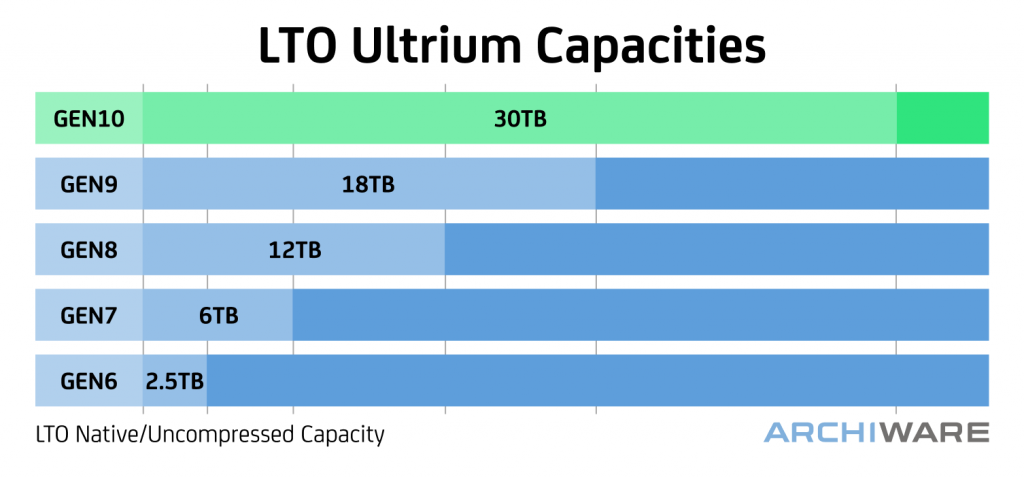
The Linear Tape-Open (LTO) format has, for many years, been a key player in data storage, especially for the media and entertainment industries that require secure, long-term solutions for storing vast amounts of data. Here’s a look at five crucial aspects of LTO to help you understand why it’s still relevant today for large and small users alike.
History
LTO technology was introduced in 2000 as a cost-effective solution for high-capacity, high-speed data storage. Initially developed with a capacity of 100GB per cartridge and transfer rates around 20MB/s, it quickly gained popularity as a reliable alternative to legacy formats like Digital Linear Tape (DLT) and Advanced Intelligent Tape (AIT). As data requirements grew, LTO evolved with each generation, increasing capacity and transfer speeds significantly. Today, it remains a popular choice for businesses, especially those in media and entertainment, where the storage of large media files is a daily necessity.
Vendors
LTO was initially developed by a consortium of Hewlett-Packard, IBM, and Seagate, collectively known as the ‘LTO Consortium‘, which continues to oversee the format’s development and specifications in 2024. Currently, IBM is the sole active manufacturer of LTO drives, while Sony and Fujifilm are the exclusive producers of LTO tape cartridges.
Many vendors package raw LTO drive mechanisms into tabletop units and rack-mountable ‘libraries’ which host multiple tapes and automate transport between storage slots and drives.
Pros
LTO has numerous advantages that make it appealing in data-intensive industries:
- Speed: With the latest LTO-10 generation (summer-2025 release), transfer speeds can reach up to 400MB/s (native) or higher with compression, making it viable for large-scale data movement.
- Capacity: LTO-10 cartridges can store up to 30TB (native), allowing for enormous storage capabilities in a compact physical footprint. See comparison chart below.
- Longevity: Tapes have a lifespan of about 30 years when carefully stored, making LTO ideal for long-term archiving.
- Reliability: Built-in error correction and a low error-rate make LTO a trusted option for critical data.
- Air-Gap Security: Since tapes are physically offline, they provide an “air gap” against cyber threats, offering an added layer of security.
- Environmental Impact: LTO consumes no energy while inactive, making it an eco-friendly option compared to always-on storage solutions.
- Industry Adoption: LTO has become a standard in industries requiring archival storage, from creatives in film production/broadcast media to finance and science ‘big data’ creators.

Cons
While LTO offers many benefits, it also has some drawbacks to consider:
- Speed: Although LTO is fast in terms of sequential reads/writes, it lacks the random access speed of disk-based storage, which can be limiting for frequent access.
- Hardware Requirements: LTO requires specific hardware, including drives and loaders, which can be costly and complex to set up.
- Drive Reliability: While tapes themselves are reliable, the mechanical nature of tape drives can lead to maintenance issues. Drive replacements and repairs may be necessary over time.
Costs
When comparing costs, LTO offers a favourable price-per-TB, often lower than both cloud storage and high-performance on-premises storage. Tape media costs around $4 per terabyte (at the time of writing), which is significantly more affordable than cloud solutions with recurring fees. A TB stored on tape needs paying for only once and data is safely retained for many years. However, initial investments in drives and other hardware are necessary, meaning the overall cost can vary depending on setup and scale. For long-term storage, particularly when high availability isn’t required, LTO remains one of the most cost-effective solutions on the market.
Final Thoughts
LTO continues to play an essential role in data management strategies for media and big-data industries. Its blend of affordability, reliability, and longevity ensures it’s here to stay, even as alternative technologies evolve. Optical archive storage has, at least for now, been abandoned. Whether you’re considering tape storage for its low cost, air-gap security, or long lifespan, LTO is well worth exploring as part of a balanced data storage approach.
Archiware’s P5 Backup and P5 Archive software products run on wide variety of platforms, support single drives and libraries and are completely vendor-agnostic regards hardware. They’ll leverage all the advantages of LTO, whether you need disaster-recover or long-term retention. Archiware’s P5 Data Mover extension even permits migration between cloud and LTO, for those unsure of where best to place their archive data.

